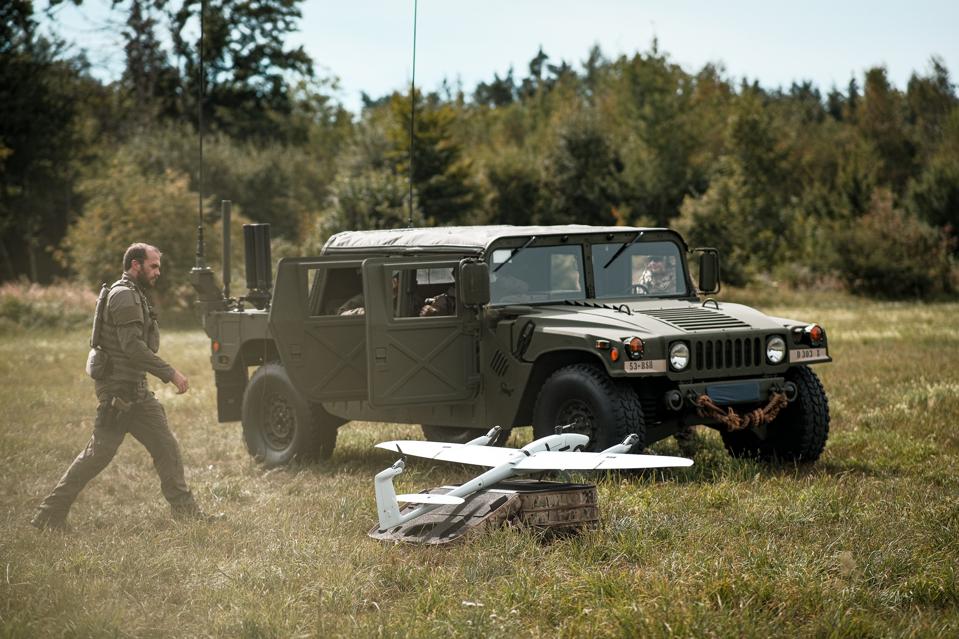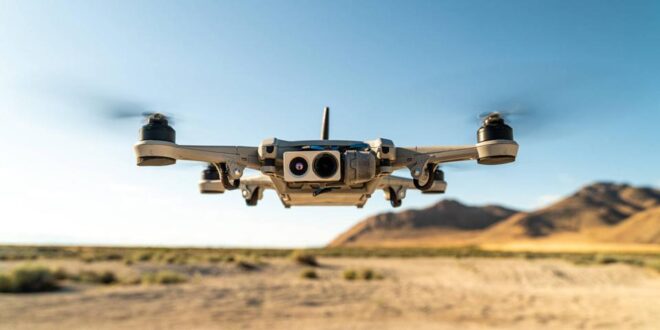A Pentagon initiative for open-source drones is sending ripples beyond the military market. Small military drones will now conform to the new Blue sUAS standard, encouraging suppliers to use software supplied by open-source leaders Auterion. Last week five new drones were cleared for purchase by U.S. military customers under the new standard. The move to open source could revitalize the American drone industry and create new opportunities for small and medium companies.
“This is not just a disruptor for the industry, it is a move of geostrategic importance,” Auterion CEO Lorenz Meier told Forbes.com
Small, low-cost drones are a tremendous military capability. A footsoldier can see what’s on the other side of the hill, or down the next street, without giving away their own position or exposing themselves to enemy fire. As insurgent groups have shown, portable drones make effective tactical bombers delivering 40mm grenades with deadly precision.
The Teal Golden Eagle, one of five drones approved under the Blue sUAS program as an alternative to … [+]
Quadcopters like DJI’s Mavic cost a few hundred dollars and fold up to fit a cargo pocket. Israel has supplied them to all its infantry units, and many U.S. forces acquired them on an ad-hoc basis. The problem is that DJI – full name Dai-Jing Innovations — is a Chinese company answering directly to the government, making their drones an unacceptable security risk. The Pentagon ruled in 2018 that military users had to find an alternative, something of a challenge due to Chinese domination of the small drone market; the only big US player, 3D Robotics, was pushed out of the drone market a few years ago. Military grade small drones such as those made by AeroVironment
The Pentagon’s Blue sUAS aims to solve the problem. ‘Blue’ as in Blue Forces meaning friendlies, and ‘sUAS’ being ‘small Unmanned Aerial Systems’ meaning drones. Blue sUAS sets an open-source standard, so that drones, ground controllers and other equipment from different suppliers will be compatible. It is based on the existing open PX4 and MAVlink software, and the Pentagon has contracted Auterion to supply their approved versions.
Meier compares the move to the transformation brought about by the Pentagon’s decision to standardize on Red Hat’s LINUX operating system for major computing projects in the early 2000s. Before that, there were a multitude of different systems, locking customers into (expensive) proprietary code and making it harder for systems to communicate. Now the US Army is the biggest user of Red Hat
Meier says few analysts yet appreciate how low-cost drones will transform warfare, or how far China is in the lead. Their consumer technology means that terrorists are using drones not available to many armies. DJI are the most used drones in terror attacks (even drug cartels are using drone bombs now) while many Western armies lack even portable reconnaissance drones.
Blue sUAS should change things radically. It will bring down costs and open up the market to new suppliers. And it will enable everything to work together.
“The military are trying to integrate the data feeds from tanks, aircraft, drones and soldiers to gain situational awareness. You can’t do that if you need to bring in contractors from sixty different companies into the discussion. Open source makes integration a lot easier,” says Meier.
Open source breaks the reliance on specific suppliers. All five of the new drones displayed last week use the same standard for ground controllers. Switching drones does not mean having to set up a new supply chain, training, and maintenance facilities. Meier notes that in future ground robots are likely to be compatible as well.
“Existing vendors will fight it,” says Meier. “We are playing a long and steady game here, and we will win because we can deliver what the customer really wants.”
The battle is likely to be a bitter one for AeroVironment, the long-established supplier of tactical U.S. Army drones, with thousands of RQ-11 Raven and RQ-20 Puma drones in service.
“I see a new category of air vehicle replacing the AeroVironment drones,” says Meier. “We expect them to be replace by new vertical take-off drones which will be much easier operate, running open source.”

Auterion partners with Quantum-Systems to bring to market Vector, a rucksack-portable tactical drone … [+]
Open source also means that rather than developments being carried out in isolation by individual vendors, there is a whole software development community. Meir notes that there are already over ten thousand Px4 developers, “a crazy, massive number.” Any new development, whether it’s a matter of linking to machine-learning to spot targets, an autopilot that deals better with crosswinds, integrating a new type of sensor, or even new dogfighting algorithms could easily be ported across an entire drone fleet. This will become increasingly important as autonomy and smart AI become the norm.
Drones will be defined by how smart they are and what they can do, not how fast or how high they can fly. Tactical intelligence, flexibility, and teamwork – all enabled by software – will be decisive in drone warfare.
“Software is now the dominant factor for drones,” says Meier, comparing the situation with smartphones which are essentially defined by their software. “Any company who is fundamentally hardware is losing.”
Looking forward, Meier believes that Western companies need to regain air superiority at low altitude, likely to be achieved with largely autonomous swarming drones.
“If someone sends thirty drones at you, will you deal with them manually one by one? I don’t think so,” says Meier. “A human operator will control a swarm rather than an individual unit; in this case they will need to direct thirty drones to defend themselves.”
The current work is focused on small drones, so-called Group 1 and 2, of up to 55 lbs, and Meier is reluctant to discuss longer term plans. However there is no reason why the software could not ultimately be extended up to Reaper-type, Group 5 drones. Which might themselves act as launch vehicles or motherships for a mix of smaller drones and loitering munitions, all using the same open-source software, all made in America.
“Blue sUAS represents a tremendous first step toward building a robust and trusted UAS domestic industrial base,” Michael Kratsios, acting US undersecretary of defense for research and engineering stated in a Pentagon press release.
That base is starting from a low level compared to the might of the Chinese led by DJI. But with Pentagon financial backing, the power of open source, and a huge global market to play for, the potential for growth seems virtually limitless.
 Unmanned Aerial Vehicle The latest drone news
Unmanned Aerial Vehicle The latest drone news




